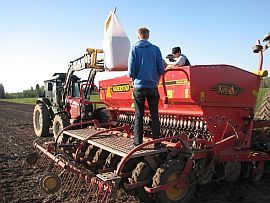Agriculture, Analytics, Employment, Estonia, Markets and Companies
International Internet Magazine. Baltic States news & analytics
Wednesday, 24.04.2024, 10:49
Estonian agriculture is characterised by large holdings and the maintenance of permanent grassland
 Print version
Print version |
|---|
In 2010–2013, the number of agricultural holdings decreased by 2%. In recent years it is common in Estonia that after finishing their agricultural activity, the holders do not rent out their lands, but prefer to continue with the maintenance of their permanent grasslands for which the supports can be applied from the Agricultural Registers and Information Board. In three years, the number of holdings which do not produce agricultural products but only maintain their land in good agricultural and environmental condition has increased by almost 1,000. At the same time, the number of larger producers has also increased.
The utilised agricultural area of agricultural holdings continued to increase in 2010–2013, grew by 17,000 hectares and reached nearly 958,000 hectares in 2013. The increase seems to be mainly related to the use of land which was previously registered by agricultural holdings as unutilised agricultural area. Although the unutilised agricultural area of agricultural holdings has decreased by a half in three years, it still accounts for more than 13,300 hectares. Additionally, there is unutilised agricultural area also outside active holdings. So it is theoretically possible that the increase will continue but it is still closely related to the economic situation and possible restrictions planned for the maintenance of permanent grasslands. The latter may have impact also to the land rents.
In 2013, only 39% of utilised agricultural area was used by owners, 54% was rented and 7% was other tenure, of which the main share is land which is used free of any charge. Large holdings depend on rented land much more than smaller ones. Compared to 2010, the area of rented land has increased by almost 22,000 hectares.
In 2013, the number of holdings which had livestock or poultry was 8,400 and, compared to 2010, their number has decreased by 1,300. The number of holders has decreased in the case of all animal species. At the same time, there has been no remarkable decrease in the number of any livestock species and, instead, the number of cattle has increased by 9%, mainly on account of beef cattle. So, it can be said that the concentration increases also in livestock farming.
In 2013 there were 49,600 persons involved in farm work in agricultural holdings. 13,300 of them were regular employees, 4,800 non-regular employees and 31,500 holders or family labour force. Compared to 2010, the number of permanent employees has increased by 400 and family labour force by 8,200. During the last decade, the number of labour force decreased because a number of small holdings finished their agricultural activity. In the last three years there have been no remarkable changes in the number of agricultural holdings, but still one in every seven persons has withdrawn from farm work. On the one hand, already a quarter of agricultural holdings do not produce agricultural products but only maintain their land in good agricultural and environmental condition and therefore need only minimum labour input. On the other hand, agricultural production concentrates more and more to the larger holdings, which use their labour force more efficiently.
Agricultural holding is a holding where there is at least one hectare of utilised agricultural area or where agricultural products are produced mainly for sale.
The 2013 Farm Structure Survey was partly financed by the European Union.








 «The Baltic Course» Is Sold and Stays in Business!
«The Baltic Course» Is Sold and Stays in Business!

